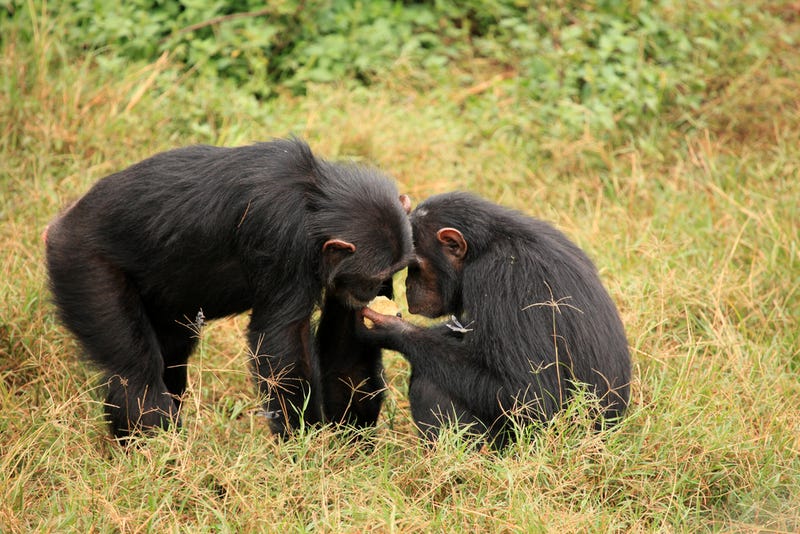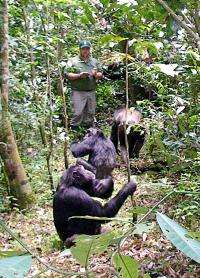Chimpanzees: Observational Study - words
Immunology Abstract The study of free-living animal populations is necessary to understand life history trade-offs associated with immune investment. To investigate the role of life history strategies in shaping proinflammatory cell-mediated immune function, we analyzed age, sex, and reproductive status as predictors of urinary neopterin in 70 sexually mature chimpanzees Pan troglodytes at Ngogo, Kibale National Park, Uganda. In the absence of clinical signs of acute infectious disease, neopterin levels significantly increased with age in both male and female chimpanzees, as observed in humans and several other vertebrate species. Furthermore, males exhibited higher neopterin levels than females across adulthood. Finally, females with full sexual swellings, pregnant females, and post-reproductive females, the oldest individuals in our sample, exhibited higher neopterin levels than lactating females and cycling females without full swellings. Together, our results provide evidence of ample variation in chimpanzee immune activity corresponding to biodemographic and physiological variation. Future studies comparing immune activity across ecological conditions and social systems are essential for understanding the life histories of primates and other mammals. Download PDF Introduction Activation of the immune system, a key component of somatic maintenance and survival, likely poses trade-offs with development and reproduction 1 and may even accelerate organismal senescence 2 , 3. Consequently, investment in immune function is hypothesized to vary according to its relative importance in maximizing reproductive success in a particular life stage or ecological context 4. Unravelling these complex interactions requires that we study organisms within the ecological conditions to which they are adapted. Chimpanzees: Observational StudyChimpanzees: Observational Study Video
The Secret Culture of the Apes - Free Documentary NatureIntroduction
Thus we study various aspects of physical cognition that can inform us about the cognitive processes that the great apes use to solve problems. We have focused our attention on three main areas: spatial cognition, planning, and causal knowledge. Spatial cognition and memory We have investigated spatial frames of reference from a phylogenetic, ontogenetic and cross-cultural Chimpanzeees:. We have found that nonhuman apes and 1-year-old children focus their attention on spatial information e. This has led us to hypothesize that at least in the great ape family, Chimpanzees: Observational Study coding is more ancient than featural coding.
Navigation menu
Further studies suggest that culture, and language in particular, plays an important role in the development of this in human ontogeny. We have continued to work on how apes encode and retrieve spatial information from memory. Previously we had established that orangutans can remember what is where.

However, this has never been systematically quantified and it is unknown how much exposure is necessary to acquire such knowledge. We investigated the speed of acquisition and the long-term retention of food locations in chimpanzees by hiding rewards in their indoor area and measuring whether they revisited those locations once they had discovered the reward on a previous day.
Primate Observation
Chimpanzees: Observational Study We found that chimpanzees were capable of remembering food locations after a three-month period Suggested readings Haun, D. Evolutionary psychology of spatial representations in the Hominidae. Current Biology, 16 17 DOI BibTeX Endnote Planning If memory can allow subjects Observatiobal store useful knowledge, planning is an essential component to put that knowledge to good use, particularly in novel situations.
We have found that orangutans and chimpanzees can spit water inside a tube to make an out-of-reach peanut located at the bottom of the tube float into reach. The solution to this task had all the hallmarks of insightful Attention span Essays solving and it represents the first case in apes of using water Chimpanzees: Observational Study a tool. We Observationap discovered orangutans and gorillas selecting and transporting tools to various locations to solve particular problems, and systematically selecting the appropriate tool based on a mental template of the features that make a tool suitable.

We have also investigated whether apes can perform an action in the present not for its present consequences, but for the consequences that it will have in the future. We found that bonobos and orangutans can select, transport and save a tool to use it the next day. This means that these species have some ability to plan for future needs. We would now like to know if apes will make a tool that they not currently need and save it for a future occasion something that has been hypothesized to play a key role in human evolution. We are also investigating whether subjects can keep track of the time that Chimpanzees: Observational Study elapsed since the occurrence of certain events — an aspect that is related to mental time travel and future planning.
Our current results strongly suggest that chimpanzees can keep track of how long it has been since a reward was Chimpanzees: Observational Study under one of three cups. Suggested readings DOI BibTeX Endnote Causal knowledge Previously we established that subjects understand many of the relations between objects and their effects in the environment. We have now turned our attention to causal understanding in tool-using tasks.]
Willingly I accept. In my opinion, it is an interesting question, I will take part in discussion.